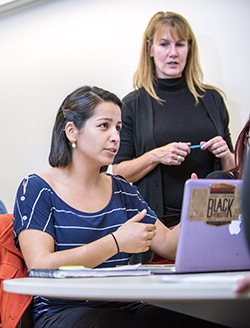“We’re giving students a chance to demonstrate what they’ve learned and also contribute to a project that has real-world applications,” says Paynton, who co-teaches the class to seniors.
In COMM 490, students are getting hands-on experience updating and revising Survey of Communication Study, a free, open source Wikibook written by Paynton and Hahn in 2009. The students’ work will lead to the second edition of the textbook, which will be used by students taking introductory communication courses across the country.
“There’s a lot of commitment at HSU to hands-on learning and undergraduate research, so the opportunity to do this was exciting,” says Hahn.

The Internet, social media, and technology have all contributed to rapid changes in communication in recent years. In COMM 490, students not only get a chance to find links to images, YouTube videos and newspaper articles that reflect those recent shifts, they also edit the actual content of the text. Eventually, the updated text will be available online, in PDF version, and in hard copy through Amazon at a reduced cost.
“We’re able to take our knowledge, skills and personal experience and apply it to a text that we have already used before,” says Brooke Howell (’14, Communication). “It’s also cool to be a student editing a textbook that you know will be used by another student.”
Knowing their work will have a lasting impact on future generations increases students’ motivation, Paynton explains. “Students aren’t motivated by an ‘audience of one.’ What I mean by that is that as professors we are often the only people that see our students’ work, which isn’t always very motivating to students. This course gives them a broader audience, increasing their intrinsic motivation. It is also something they can eventually show future employers.”
The class is part of a larger trend at HSU and universities around the country to explore affordable learning options. According to Cyril Oberlander, Dean of the Library, the rising cost of textbooks can be a big deterrent for many students. Students, on average, spend up to $1,200 a year buying required textbooks for their classes. At HSU this fall semester, six required textbooks cost over $300.
The high cost leaves a lot of students looking elsewhere: finding cheaper options online, checking out books through the Library’s reserves or simply going without. “Increasingly, students are making the decision not to buy their textbooks, which jeopardizes student success,” says Oberlander.
HSU is looking at alternatives, such as making more titles available to students on library print reserves and encouraging faculty members to explore affordable learning options. The library also recently launched an Open Educational Resources guide for faculty online.
Next year, HSU will apply for CSU’s affordable learning solutions grant to incentivize adoption of affordable learning and authoring open textbooks. Open Textbooks are textbooks that are free online, and can be affordable in print. The changes could represent significant cost savings for students and the university.
“Imagine if you have an introductory course and students are paying $200 each for a textbook,” Oberlander says. “If you multiply that by the number of students who buy the textbook, you could be talking about saving $15,000 over two semesters.”
“As students, we already have a lot to worry about,” agrees Katie Lowe (’15, Communication), a student in Hahn and Paynton’s communication class. “Being a part of the open source movement to make textbooks more affordable will give students one less thing to worry about.”
Faculty interested in learning more about open educational resources should visit the CSU’s Affordable Learning Solutions project. Other high quality, peer reviewed catalogs are OpenStax, Open Textbook Library, Open SUNY Textbooks, and OER Commons.